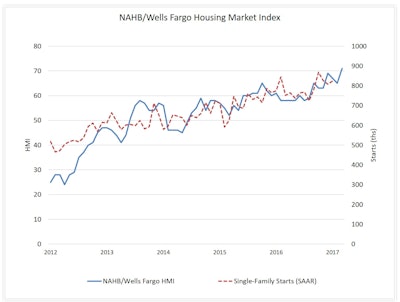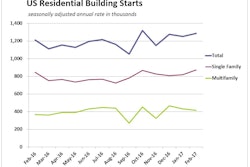
Builder confidence in the market for newly-built single-family homes jumped six points to a level of 71 on the National Association of Home Builders (NAHB)/Wells Fargo Housing Market Index (HMI). This is the highest reading since June 2005.
“Builders are buoyed by President Trump’s actions on regulatory reform, particularly his recent executive order to rescind or revise the waters of the U.S. rule that impacts permitting,” said NAHB Chairman Granger MacDonald, a home builder and developer from Kerrville, Texas.
“While builders are clearly confident, we expect some moderation in the index moving forward,” said NAHB Chief Economist Robert Dietz. “Builders continue to face a number of challenges, including rising material prices, higher mortgage rates, and shortages of lots and labor.”
Derived from a monthly survey that NAHB has been conducting for 30 years, the NAHB/Wells Fargo Housing Market Index gauges builder perceptions of current single-family home sales and sales expectations for the next six months as “good,” “fair” or “poor.” The survey also asks builders to rate traffic of prospective buyers as “high to very high,” “average” or “low to very low.” Scores for each component are then used to calculate a seasonally adjusted index where any number over 50 indicates that more builders view conditions as good than poor.
All three HMI components posted robust gains in March. The component gauging current sales conditions increased seven points to 78 while the index charting sales expectations in the next six months rose five points to 78. Meanwhile, the component measuring buyer traffic jumped eight points to 54.
Looking at the three-month moving averages for regional HMI scores, the Midwest increased three points to 68 and the South rose one point to 68. The West dipped three points to 76 and the Northeast edged one point lower to 48.


















